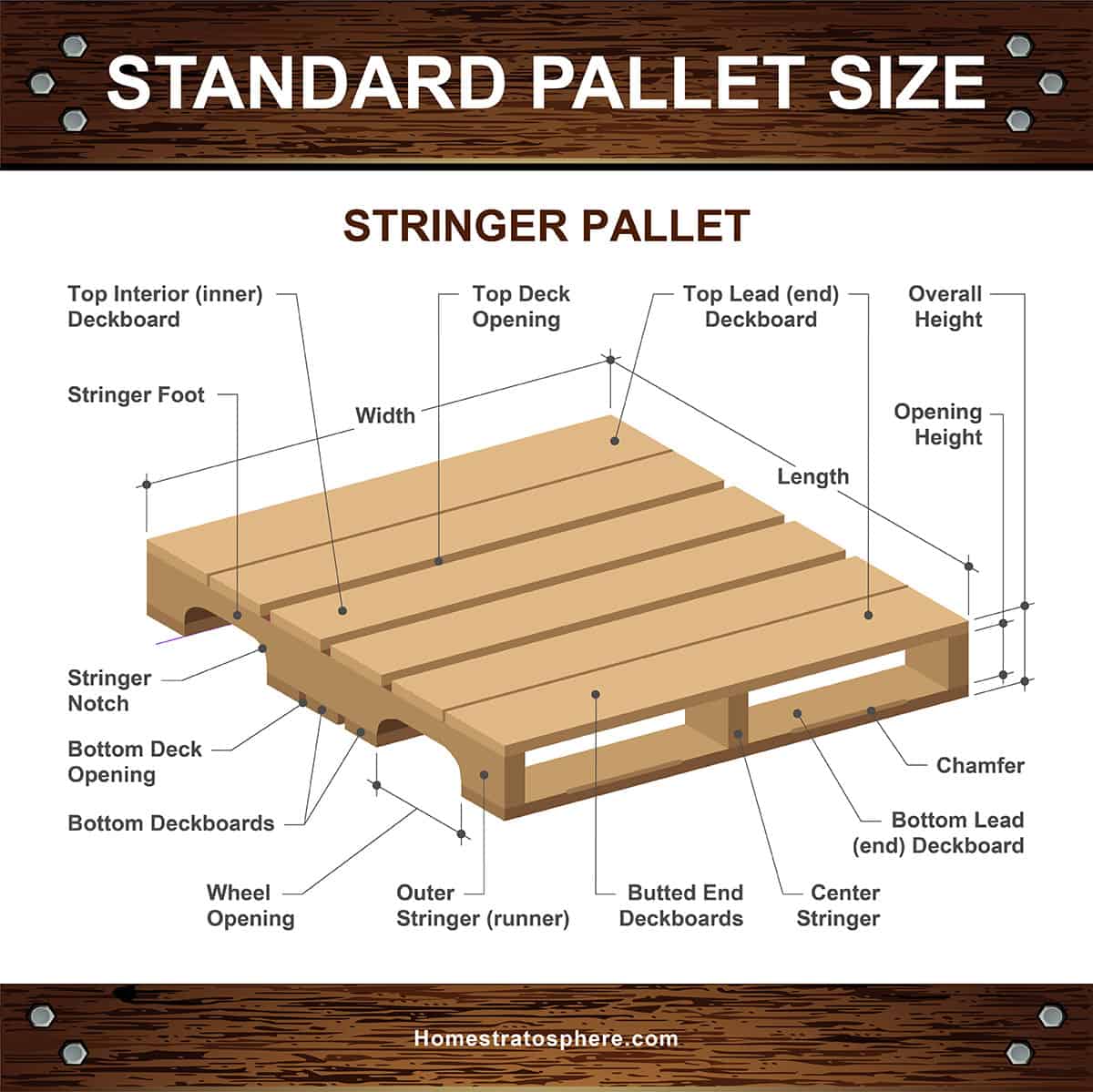
For shipping your goods or products from one place to another, you need to secure the products by stacking them on pallets and safely loading them onto the containers. The pallets can be wooden or plastic and they can unlock multiple benefits like utilizing all the available space, holding the products intact in one place, and allowing the perfect opportunity to save time and money. If you have all the right dimensions, you can use the perfect pallet size to save your time and bring the shipping cost down/
Depending on the size of cargo you can book a complete truckload or go for a less-than-truckload but before making the decision, you need to know about the standard sizes so your shipment is secured and no space is wasted. About pallets, there will be questions like how high the pallet can be, and how wide is wide enough? These dimensions can help in utilizing the maximum space of the truck.
About Pallet Shipping
In simple terms, the pallet is anything that can be used as a base and different goods can be stacked on top of it with a strong base to support the weight. Generally, the pallets are available in wooden but you can choose plastic and metal ones as well. For bulk shipments, pallets come in handy and the products can be transported securely from one place to another. The boxes or bundles are stacked on top of each other and at the final step, the whole pallet is covered with shrink wrap from the base of the pallet to the top giving it the necessary support for secure movement. The majority of the companies use wooden pallets as they are cheap while some of the mares switch to plastic as well for its durability.
Palletization can help in achieving both goals of efficiency and secure transportation. With a strong base, stacking gets easier and you eliminate the high risk of products getting damaged during transit. With designated space for forklift blades, loading and unloading are smoothened out to great extent.
The usual square or rectangle sizing of a pallet also aids carriers in maximizing space. When a van can deliver more products in one trip, you and your operator save time and money. Using a pallet ensures that your shipment is handled correctly by your carrier and that the products do not shift during transit. When shipping multiple packages to a single location, putting them together on the same platform is frequently the best option. They will all reach their destination at the same time, and because they are protected by shrink film, they will remain safely aboard the truck.
Palletizing a Shipment
Palletization is the key part to make sure your products are safe and there are certain rules you have to follow. These rules are set by shippers to make sure that your products reach their destination safely and securely. Before we get into Palletization, you need to understand what sort of pallet will suit your goods the best. You don’t want to stack them hap-hazardously or stack them so high that it would be impossible to move. If you have gone through the guidelines, you would know how much height is appropriate and how you can stack them neatly so none of your products gets damaged in transit. To make sure that the goods are in optimal condition, you need to get the right size for the right material. Corrugated boxes would be a wise choice to pack them neatly and stacking can become much easier. Once you are done with packing and CBCs are ready to go, you need to check the strength of the pallet. You don’t want to overweight the pallet as it can break mid-transit and you’ll end up sending the damaged products to your customers which is not good for business. To get a rough estimate, you need to go through a few variables that contribute to the load limit of the pallet. Those variables are the type of wood, the thickness of the material, and supporting fasteners to hold the pallet in one place. So, in addition to the physical dimensions of a platform, you need to consider features such as load capacity.
Standard Pallet Shipping Dimensions
To answer the typical question of standard pallets, you need to understand there are no fixed dimensions that can be labeled as standards. Pallets come in different shapes and sizes depending on the demand of the customers. 48 x 40 dimensions are widely used and the majority of the shipments are done on these pallets. However, if the products demand different dimensions then the pallets can be adjusted so there is no hard and fast rule to standardize the pallets.
- 40 x 48 pallets are widely used to transport groceries and general food items that can be stacked.
- 40 x 42 pallets are ideal to ship telecommunication equipment and in the market, these pallets are famous as paint pallets.
- 48 x 48 pallets are the largest squared pallets out there and are frequently used to ship liquid-holding drums. These drums are used to ship oil and casings of different kinds to different industries.
- 48 x 42 pallets are preferred by soft drinks companies and other beverages. Chemical industries also go with these pallets
- 40 x 40 pallets are used to transport dairy products and mostly plastic pallets are preferred to ensure food safety and avoid contamination.
- 40 x 24 pallets are customized pallets used to allow movement through narrow openings like aisles of small retail stores. With the dimensions cut in half, the owners can enjoy free movement and fewer constraints.
What are the most common standard pallet sizes? According to the National Wooden Pallet and Container Association (NWPCA), 40” x 48” pallets account for 35% of all newly made pallets, the highest proportion created in a single size. 39 percent are non-standard sizes, demonstrating that bespoke sizes are still popular possibilities. It’s worth noting that the proportion is falling. In 2011, 60 percent of shipping pallets were non-standard in size.
As per the discoveries in industry data, 48” x 48” inches is the second-most frequent size after 40-by-48 inches. 42” x 42” inches is the third most common size. The Worldwide Organization for Standardization (ISO) offers six standard pallet sizes in its ISO 6780:2003 standard, with the majority specified in millimeters for international usage. The other typical ISO pallet size used in North America, after 40-by-48 inches, is 42-by-42 inches, or 1,067 square millimeters. While the 48-by-48-inch platform is not on ISO’s list, it is widely used to transport oil and casings to multiple industries.
Standard pallet dimensions are helpful in logistics because they allow carriers to maximize truck space. If every cargo on a single truck has the same-sized base, even if shipping from different customers, the carrier can put as many palletized goods as possible on one vehicle.
Types of Pallets
IT is pivotal to understand the type of platform before you start loading your good on it to avoid any damage. Every pallet design is specific to a certain type of load and not everything can be loaded on a pallet. Some basic knowledge and critical handling are required and you don’t have to be shy about asking your carrier company to help you out in that matter. Professional companies like Zorka’s would love to help their customers and their online service can help you understand all the basic questions and you can be at peace mentally once you are done with stacking. TO understand the concept of the right type of pallet, let’s go through some types of pallets.
Block Pallets
A block pallet can be considered a more convenient type of pallet as a forklift can lift the pallet from any side due to its four-way entry. For the logistics department, block pallets are easy to handle as the workers and supervisors don’t have to worry about placing the pallet with the correct side up front for the forklift pick up. So, as per the dimensions of the warehouse or cargo container, they can be adjusted either length-wise or width-wise. Hand pallet trolleys can enter from any side and movement is possible from any direction. Talking about its physical attributes, nine blocks works as a support for the top side and the weight gets evenly distributed throughout the pallet. With nine supports, there is enough spacing for the hand pallet trolley or forklift to access the pallet and lift it whenever required. These blocks also act as a base, however, there are few block pallets with a lower deck and the block supports would lie in-between the upper and lower deck.
Double-Wing Pallets
Double-winged pallets add more surface area allowing the pallet to hold more goods and weight. Just think of a stinger pallet but the top deck has an extended area on both sides giving it a wing-like shape. There are pallets with only one side extension commonly known as single-wing. Stingers can be replaced with blocks but the concept remains the same. The type of pallet is dependent on the material that needs to be stacked and more surface area is required.
Stringer Pallets
Stringer pallets got their name from the three stringers supports between the upper and lower deck. One stringer on each side and one would run in the middle. With stringer-type support, pallet trolleys and forklifts can only access the pallets from 2 sides so, during movement, the workers need to make sure that the accessible side is facing the front. If the stringer side is on the front, then the worker might have to empty the complete bin just to access the pallets from the side. For two-way accessibility, stringer pallets are also known as two-way pallets. In some cases, stringer pallets have notches to allow the forklift accessibility from all sides making them more versatile and handy to use
Double-Face Pallets
A double-faced pallet is made for sheer strength and can hold more weight than usual pallets. Further down the line, there are two types one is reversible in which both sides can be used to stack goods. On the other hand, the top deck is stronger and the weight gets evenly distributed because of the strong base.
Solid Deck Pallet
As the name suggests, this type of pallet has one solid sheet instead of multiple slats. These types of pallets are mostly made up of plastic and they are easy to clean. Therefore, many food processing industries go with solid deck pallets to maintain hygiene and reuse the pallet multiple times. For sophisticated clients, solid pallets give you the option to present the goods more gracefully, and displaying of products gets easier and classier
How Many Pallets Fit in a Truck?
How many pallets are in a truck is a crucial question and multiple factors need to be accounted for. There are numerous ways a truck can be loaded and if you are careful, you can utilize all the space that a truck has to offer. With Zorka Transport LLC, dry vans are spacious and two rows of standard pallets can be adjusted easily.
Talking specifically about the dimension, the truck’s usable space in width is 96 inches. So, to load two rows, the pallets need to be 48 inches in width or less. This is where the standard pallets play a big role as the space is utilized completely and more product is transported in one go. For the pallets exceeding the standard limit, only one row can be transported and if you are a small business owner then the logistics cost can hamper your operations.
We have talked about width but what about the height? Yes, if you are using the double stacking technique, then you need to consider the height factor as well. Any pallet exceeding the 48-inch limit is going to limit the truckload to a single stack again costing you a lot of money in transportation.
53-Foot Trailer
You got to know your trucks if you want to check how many pallets you can fit in one container. You know about the size of a standard pallet by now right? A 53-footer is 636 inches in length so by simple mathematics you can accommodate 26 pallets having 2 rows of 13 pallets each. Now, you can go with double stacking if the product is not fragile and the pallet height is less than 48 inches. This way, a total of 52 pallets can be accommodated in a 53-foot trailer.
48-Foot Trailer
The 48-foot trailer is slightly smaller as compared to 53 inches one so one pallet gets removed from each row giving you a total of 24 pallets single-stacked. For double-stacking, multiply it by 2 and you’ll get a total of 48 pallets.
24-Foot Box Truck
The 24-foot truck is 288 inches in length meaning you can accommodate 12 pallets with 2 rows with a pallet dimension of 48 inches or less. Stackable pallets can increase the number and take the count to 24.
16-Foot Box Truck
16-footers can store 8 pallets single-stacked and 16 double-stacked.
Flatbed
Flatbeds are different from reefer containers or food trucks. They are similar in length to 53-footer or 48-footer but with an open roof. However, there’s a legal limit to the width which is 8.5 feet. The open roof allows extra 6 inches than the usual 48 inches standard. This way you can stack another layer to the pallet and transfer more pallets in one trip.
Pallet Shipping FAQ
How skids and pallets are different from each other?
We have often heard skid and pallet terms used in normal conversation and some might think that both terms are the same. However, skid has only a top layer and you have mostly seen them in storage warehouses with minimal movement, While pallets have both top and bottom layers and are widely used for transportation.
How many pounds you can stack on a pallet?
Standard pallets can hold up to 4600 pounds of weight. The weight limit can vary depending on the thickness of the wood, surface area, and supporting lower deck threshold.
How Much Does a Pallet Weigh?
Apart from the weight, a pallet can hold, an idle pallet can weigh up to 35 to 48 pounds. Again the range is varying depending on the fasteners and the type of wood used to manufacture these pallets. The same goes for plastic as well. Lightweight plastic can reduce the idle pallet weight but the pallet will hold less weight than heavy-duty plastic pallets than can weigh more than 48 pounds without any load.
What is the height of the pallet from the ground?
The pallet itself is 6 inches high meaning that the top deck and bottom deck are separated by six inches and the total height of the product can reach up to 48 inches for a standard pallet.
How High Can You Stack a Pallet?
Keeping in view of the legal height limit, a single pallet can be stacked up to 60 inches. However, you got to keep in mind that the double stacking would go out of the window. So, you need to make a decision whether you want a single pallet with 60 inches or go with a standard 48 inches height and enjoy double stacking and secure transit.
Zorka Transport LLC can help you in clarifying all the questions that you might have regarding Palletization and can hook you up with pallets catering to your needs. Our customer care department heavily invests its time and energy to help every client and can plan out your demands in a customized package.

